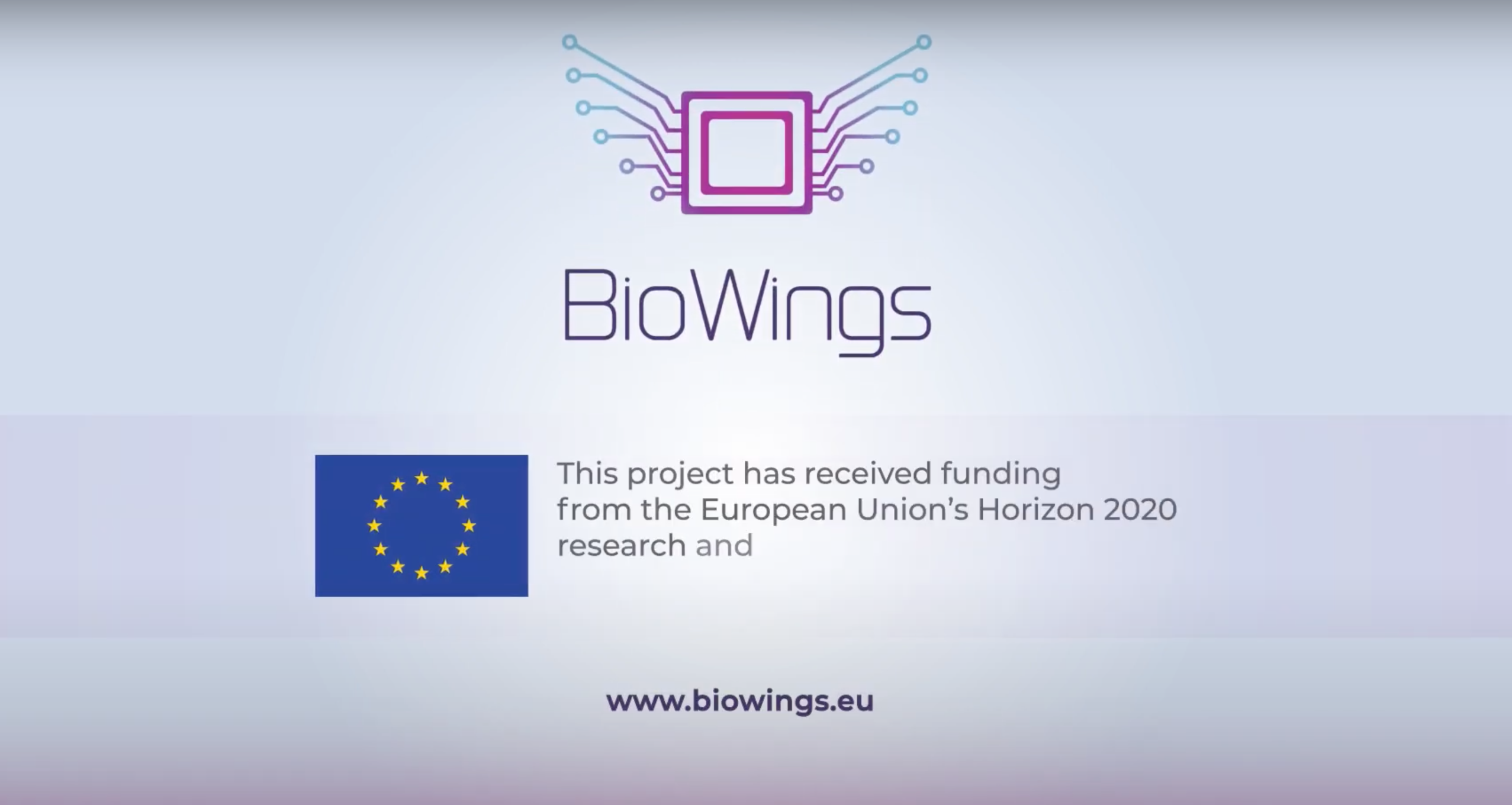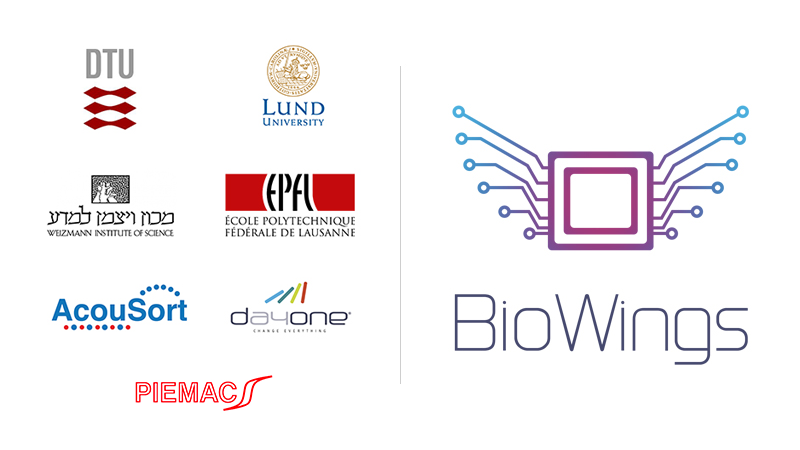
Scientific Articles from BioWings Consortium
Watch out for the new scientific publications on the RESULTS section.
Links on:
https://www.biowings.eu/the-project/
Fracture strength and fatigue endurance in Gd-doped ceria thermal actuators.
ABSTRACT
We studied the stability of the mechanical properties and the fatigue endurance of Gd-doped ceria (CGO), which is a promising electromechanically active material for microelectromechanical systems (MEMS). Specifically, the fracture strength and long-term operation of plate-type circular (2 mm diameter) thermal actuators made of ≈1.15 μm thick Ce0.95Gd0.05O1.975 (CGO5) were investigated. Excitation voltage of 10 V at the frequency range between 1 and 2.1 MHz induces Joule heating effect that can generate an in-plane strain of ≈0.1 %. The operation temperature ranged from 25 °C to 80 °C and the temperature shift, caused by the AC heating, was about 80 K at 10 V. Critical fracture was found to occur at out-of-plane displacements between ∼35 and ∼42 μm, which corresponds to the average bending stress of ∼44 MPa at the center of the plate. During long-term operation, the actuators exhibit gradual decrease in the response, probably due to contact degradation. However, structural damage or mechanical fatigue was not found even after 107 cycles at a stress level of ∼30 % of the critical fracture strength.
Mishuk E. (a), Ushakov A. (b), Shklovsky J. (c), Krylov S. (d), Shacham-Diamand Y. (c), Shur V. Y. (b), Kholkin A. (e) & Lubomirsky I. (a)
(a) Department of Materials and Interfaces, Weizmann Institute of Science, Herzl St 234, Rehovot 7610001, Israel.
(b) School of Natural Sciences and Mathematics, Ural Federal University, Lenin Ave. 51, Ekaterinburg 620000, Russia.
(c) Department of Physical Electronics, School of Electrical Engineering, Tel Aviv University, 69978, Israel.
(d) School of Mechanical Engineering, Tel Aviv University, 69978, Israel.
(e) CICECO-Aveiro Institute of Materials, Department of Physics, University of Aveiro, 3810-193 Aveiro, Portugal.
Resonant Raman Scattering in Undoped and Lanthanide-Doped CeO2.
ABSTRACT
CeO2 has a narrow, empty band of Ce 4f states that lies between an O 2p-based valence band and a Ce 5d-based conduction band. The O 2p–Ce 4f optical band gap is positioned at ∼3.2 eV with an absorption band centered at ∼3.8 eV. We investigated the Raman scattering of bulk CeO2 in the excitation energy range of 1.96–3.81 eV. The resonant enhancement profile of the longitudinal optical (LO) phonon at ∼590 cm–1 closely follows that of the 2LO band and both profiles track the optical absorption of the O 2p–Ce 4f electronic transition. Multi-LO phonon bands were found to appear up to the sixth order, pointing to an electron–phonon Fröhlich interaction as the source of the resonant enhancement. The ∼600 cm–1 off-resonant D2 band (denoted as MO8-type complex in ceria doped with M aliovalent ions) is overshadowed under resonant conditions by the resonant LO phonon scattering. Hence, spectral analysis of defect bands under resonant conditions has to be distinct from that applied under off-resonant conditions and care must be taken when dealt with under a single framework. We investigated the resonant Raman spectra of Lu-, La-, Gd-, or Sm-doped ceria ceramic pellets as a function of increasing Do3+ mol %, in the fluorite phase range (up to 20 mol %). For La and Lu, the general trend of the Do3+ mol % frequency dependence for the D1 local mode is qualitatively similar to that of the F2g phonon and it follows the respective expansion (La) or contraction (Lu) in the lattice parameter. However, for Gd and Sm, the trend is opposite to the F2g mode. This trend may stem from local lattice contraction around point defects, which was suggested, based on local structure probes such as X-ray absorption spectroscopy and pair distribution function analysis of X-ray diffraction. Our analysis provides access to average as well as to local structures of ceria solid solutions, via resonant Raman spectroscopy.
Kraynis O. (a), Lubomirsky I. (a) & Livneh T. (b) (2019) Journal of Physical Chemistry C. 123, 39, p. 24111-24117
(a) Department of Materials and Interfaces, Weizmann Institute of Science, Herzl St 234, Rehovot 7610001, Israel.
(b) Department of Physics, Nuclear Research Center Negev, P.O. Box 9001, Beer Sheva 84190, Israel.
Femtosecond laser processing of ceria-based micro actuators.
ABSTRACT
In this paper we present a novel femtosecond laser micro-processing of gadolinium doped cerium oxide (CGO) taking advantage of the unique properties of the ultra-short laser pulse. The process can be extended to other materials which are incompatible with conventional deposition/patterning/etching processes. For example, CGO electrostrictive ceramics is lead-free and non-toxic, compatible with Si-microfabrication and exhibits large electrostriction effect at low frequencies. These qualities make CGO into a promising electroactive material for MEMS applications. However, conventional CGO lithography suffers from low yield due to metal shorts and due to damage during the etch and clean processes. Wet patterning of CGO is very difficult and often results in enhanced leakage or shorts between electrodes. These process compatibility issues can be avoided by using laser patterning. As a proof of concept, a precise patterning of electro-active ceramic Ce0.95Gd0.05O1.975 (CGO5) thin films (1.7 μm-thick) by femtosecond laser is demonstrated. The femtosecond laser patterning was used to fabricate double-clamped beam actuators made of CGO5 sandwiched between two metal contacts. The new process is studied and preliminary guide lines are presented. The process design rules are established; for example, a margin between the top contact edges and the CGO layer edges was defined prior to laser ablation to prevent a short-circuiting between top and bottom contacts due to metal ablation. Electro-mechanical testing of the resulting devices demonstrates the long-term mechanical and electrical endurance of 1.2 mm long beams. Using electrical excitation (voltage amplitude of 10 V with a carrier frequency of 10 MHz modulated at 10 Hz), actuation at 10 Hz induced an in-plane strain of 7×10−6 without any observable mechanical degradation for >800 k cycles. The processes presented in this work, therefore, provide a technological framework for integration of CGO into MEMS-devices.
Eran Mishuk (a), Jenny Shklovsky (b), Yuval Berg (c), Niv Vengerovsky (c), Tanmoy Paul (d), Zvi Kotler (e), Yoed Tsur (d), Yosi Shacham-Diamand (c), Slava Krylov (b), Igor Lubomirsky (a).
(a) Department of Materials and Interfaces, Weizmann Institute of Science, Hertzl st. 234, Rehovot 7610001, Israel.
(b) Faculty of Engineering, School of Mechanical Engineering, Tel Aviv University, Ramat Aviv, Tel Aviv 69978, Israel.
(c) Faculty of Engineering, Department of Physical Electronics, Tel Aviv University, Ramat Aviv, Tel Aviv 69978, Israel.
(d) Department of Chemical Engineering, Technion – Israel Institute of Technology, Haifa 3200003, Israel.
(e) Additive Manufacturing Group, Orbotech Ltd, Yavne 81101, Israel.
Effect of oxygen defects blocking barriers on gadolinium doped ceria (GDC) electro-chemo-mechanical properties.
ABSTRACT
Some oxygen defective metal oxides, such as cerium and bismuth oxides, have recently shown exceptional electrostrictive properties that are even superior to the best performing lead-based electrostrictors, e.g. lead-magnesium-niobates (PMN). Compared to piezoelectric ceramics, electromechanical mechanisms of such materials do not depend on crystalline symmetry but on the concentration of oxygen vacancy () in the lattice. In this work, we investigate for the first time the role of oxygen defects configuration on the electro-chemo-mechanical properties. This is achieved by tuning the oxygen defects blocking barrier density in polycrystalline gadolinium doped ceria with known oxygen vacancy concentration, Ce0.9Gd0.1O2-δ, δ = 0.05. Nanometric starting powders of ca. ∼12 nm are sintered in different conditions, including field assisted spark plasma sintering (SPS), fast firing and conventional method at high temperatures. These approaches allow controlling grain size and Gd-dopant diffusion, i.e. via thermally driven solute drag mechanism. By correlating the electro-chemo-mechanical properties, we show that oxygen vacancy distribution in the materials plays a key role in ceria electrostriction, overcoming the expected contributions from grain size and dopant concentration.
Ahsanul Kabir (a), Simone Santucci (a), Ngo Van Nong (a), Maxim Varenik (b), Igor Lubomirsky (b), Robin Nigon (c), Paul Muralt (c), Vincenzo Esposito (a).
(a) Department of Energy Conversion and Storage, Technical University of Denmark, Frederiksborgvej 399, Roskilde, 4000, Denmark.
(b) Department of Materials and Interfaces, Weizmann Institute of Science, Rehovot, 76100, Israel.
(c) Ceramics Laboratory, Department of Materials, Swiss Federal Institute of Technology, Lausanne, 1015, Switzerland.






